All I could think about before I swung a leg over the gorgeous deep red, black and white Indian Scout FTR750 flat-tracker before me was just how bad I’d look if I actually tossed the thing down the racetrack.
Getting the unbelievably rare chance to ride flat track racing’s most surprising warhorse since, perhaps, the emergence of the Honda RS750 of the mid 1980s was something that only a handful of professional flat trackers, let alone aging motorcycle journalists, had done since the bike’s debut in late 2016, and I sure as hell didn’t want to be the first to put one in the fence, something that no one had done during the 2017 American Flat Track Series. Quite the opposite: All they did was keep putting on top of the victory podium. And on the sides. En route to a dream season, the Indian Factory Wrecking Crew not only won 14 out of the 18 races on the series schedule, they scored six podium sweeps, and 2017 AFT Twins Champion Jared Mees broke a long-standing record by scoring 17 podium finishes all by himself. Ten of ’em were wins.
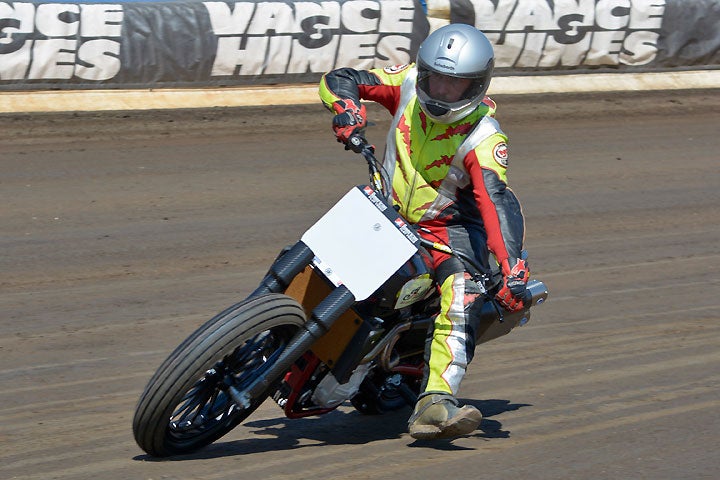
If you read our Indian Scout FTR750 Review in 2016, you’re probably well aware how it went from drawing board to race-ready machine in just over nine months, and then Indian stacked the 2017 title odds in its favor when it hired the three riders who have held the flat-track championship (among them) since 2012, including four-time champion Jared Mees, 2013 champion Brad Baker and 2016 champion Bryan Smith. What followed was as dominant a performance by a Harley-Davidson interloper as the series has ever seen. What began as an idea by Indian Motorcycle V.P. Gary Gray and Indian Motorcycle President Steve Menneto to get the Indian brand back to its roots shocked the flat track world. Even Gray has to giggle when he thinks about the timeframe.
“We had to get our core business in shape before we could even think about this,” Gray told me at Perris. “Since we started on the first production [street] bikes, we had talked about going back to flat track. We launched 11 models in three years, developed our dealer network and had a pretty good base, so we started talking about what we could do to give back to the sport. I talked to Steve (Menneto, President of Indian Motorcycle) and said, ‘Here’s an idea of something that we could do in the next two to three years.’ Then in September of 2015, Steve made the announcement that Indian would be back in flat track in 2017 or 2018. That was way faster than I was thinking, but we started designing the bike in December of 2015, and were on the track testing by June of 2016.”
Engine design and construction was handled by Swissauto, a Polaris-owned company that already had a track record designing MotoGP engines. Chassis development was coordinated with aftermarket V-Twin parts supplier S&S. A few bits and pieces were sourced from companies with long-standing reputations for producing quality flat-track parts. In light of how well the bike performed when it made its debut at the Santa Rosa mile in California with former AMA Grand National Champion Joe Kopp, it seems like such a short amount of time, but then again maybe not. The bike Kopp rode was the product of extensive testing during much of the 2016 American Flat Track season.
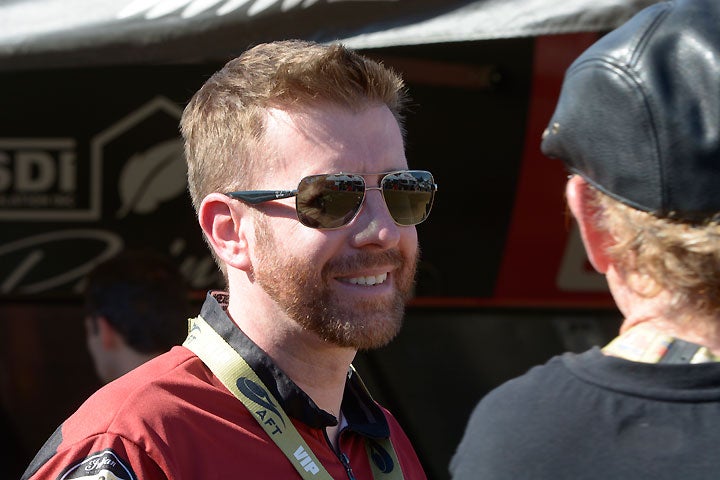
“What we did was we would rent the track after every round so that we could test on good tracks, and we finally got it to where we felt we could make a main event by the last race of the season,” Gray said. “You can test all you want by yourself, but it’s not a real test until you’re in a race. So we got Joe to ride the bike at Santa Rosa, and he qualified in our first heat, won the Dash for Cash and ran really well in the main. That was a really good test!”
With the announcement that Indian had hired Smith, Mees and Baker, everything seemed to fall into place, but the tremendous risk in that move is not lost on Gray. In racing, nothing is a given, and it was entirely possible that unforeseen failures could have made Indian look silly. Dream teams rarely experience the dream. Gray was well aware of that as he wrote down his expectations prior to the start of the 2017 season. If the Scout FTR750 could score three podium finishes, and if one of the Indian factory riders could manage a fifth-place finish in the season points standings, Indian would call it a successful year on which to build for the future.
But when Mees came out at the very first race of the year, a TT track at Daytona that no one had ever ridden before, and he led every lap of the race en route to the first national flat-track win by an Indian since the mid-1950s, the handwriting was on the wall. What followed was a 2017 season in which Mees, Smith and Baker mostly battled each other for race wins and podiums at every round of the series. When the dust settled on the 2017 season, Indian was not only back on top of the flat-track world, it broke records along the way. The 2017 AFT Twins Championship-winning Scout FTR750 tuned by legendary flat-track tuner Kenny Tolbert carried Mees to 17 podium finishes, surpassing the record shared by former series champions Scott Parker and Ricky Graham. Mees also landed 10 wins to tie all-time-winner Parker for second on the single-season winner’s list, two wins behind Graham. Smith added another four wins to give Indian 14 wins in 18 rounds.
Mees or Smith won the first eight races of season, and Baker joined them for six podium sweeps by Indian. As one final kick to the shins of its predominantly Harley-Davidson, Kawasaki and Yamaha competition, Johnny Lewis put the first of the 50 privateer Scout FTR750s slated to be built and sold to the public on the podium during the penultimate round of the series at Texas Motor Speedway, proving that there is no appreciable performance difference between what Indian sells and what its factory team races. How’s that for a debut season?
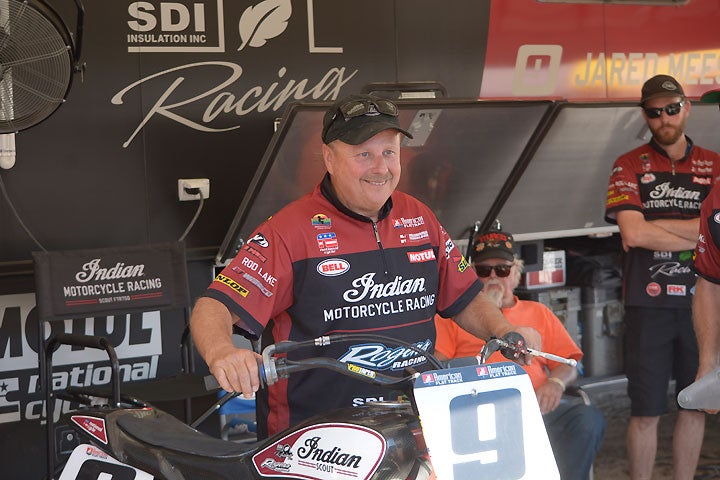
Talking to Tolbert about the Scout FTR750 was like old home week. During my years covering the series full-time from 1995 through 2006, I could always count on him to tell me the truth, good or bad. When talking about the Scout FTR750, a project that he became involved with from the drawing stage, the news is almost entirely good from his perspective.
“As soon as I heard about it, I knew I wanted to be a part of it,” Tolbert said. “We started looking at the drawings, and I told them, ‘We gotta have this, and we gotta have that,’ and, ‘This is where the engine needs to be in the chassis.’ We took the dimensions right off a Harley and went from there. Swissauto built such a great, compact engine. We spent a lot of time messing with crank inertia, flywheel mass and sizes. It’s a great bike. It’s everything you’d want in a dirt-track racing engine.”
I wanted to experience the Indian’s magic, but I was also a little more than scared at the same time. As a former Pro-Am flat-track racer, I have a reasonable amount of experience turning left on dirt ovals, but it had been over 15 years since I last slid into a curve on the super-sticky clay of the half-mile Perris Auto Speedway track and I didn’t want to look like a dumbass. I was fourth in line to ride the machine, a smart move I thought — unless one of the journalists ahead of me managed to toss the thing, which would probably have ended our day. Soon enough, it was my turn. No time to think about it or talk myself out of it. Before I knew it, I was letting out the clutch and pulling onto the track.
Each of us would only get five laps plus the cool off to gain a perspective on the Scout FTR750. Five laps. Just a taste. Drug dealer tactics. The first high is free and then you start paying.
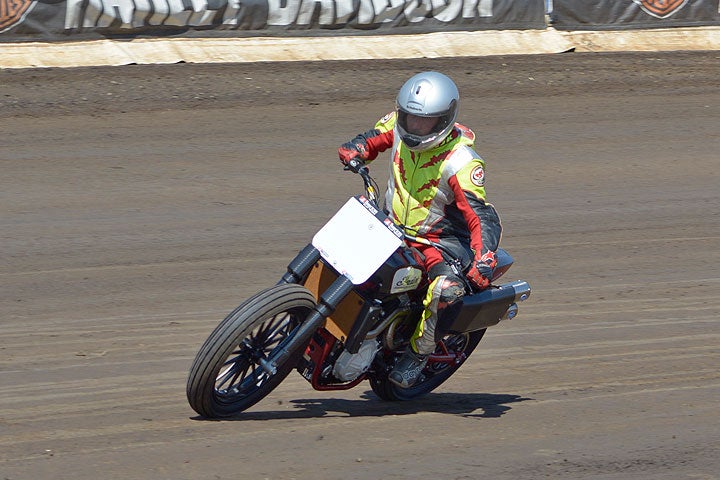
That said, in those five laps I remembered quite a lot, and it was amazing to me how my stint brought me right back to the last 750cc flat-tracker I’d ridden on a half mile, 12 years ago, when I was granted the opportunity to ride series-champion Chris Carr’s Tolbert-tuned Harley-Davidson XR750. Boy, was Carr ever right when he proclaimed after testing the Scout FTR750 for us at Santa Rosa last year that this was the kind of bike Harley-Davidson should have built 15 years ago.
For starters, despite its aggressive, athletic exhaust note, the Scout FTR750 is sewing-machine smooth – I never felt a hint of vibration through the handlebars or its thinly padded carbon fiber seat. I couldn’t say the same about Carr’s XR all those years ago, and Tolbert confirmed in my mind what my hands, feet and butt had already told me.
“It has counterbalancers, the way they did it, and it’s so electric,” he said. “It doesn’t shake at all.”
Immediately trying to get a feel for the Scout FTR750’s power delivery, I went ahead and whacked the throttle as much as I dared, and its fuel-injected V-Twin responded with the most linear yet forceful pull I’ve ever experienced on flat-track machine. Harleys I’ve ridden have a lot more flywheel effect, so they tend to be a little slower to regain lost revs, but at the same time that stored energy will grab traction and suck you into a corner if you back off the gas, which can be a harrowing sensation if you’re not ready for it. The fast Harley guys very quickly learn to manage that power delivery and keep the XR’s tractor-able engine singing in a happy place that allows them to convert that flywheel mass into drive. Here again, Tolbert backed up that feeling after the fact.
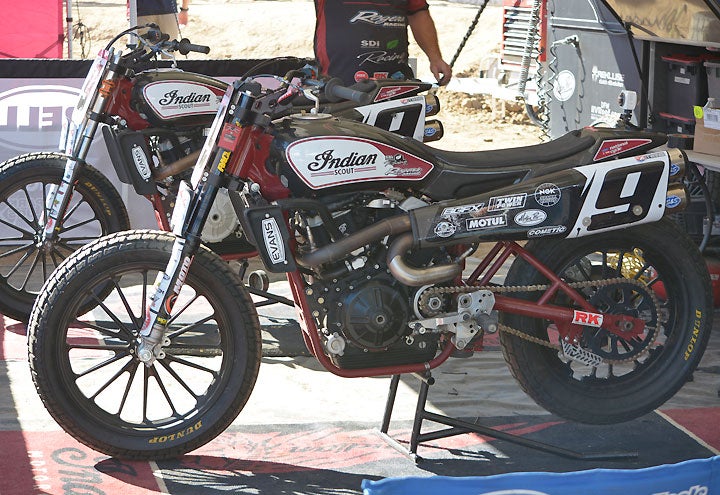
“You can feed it the gas, and it just picks up its feet and goes,” Tolbert said. “With the Harleys, even when you pick up the gas, they don’t really go.”
On top of that, the pushrod, two-valve XRs have always paid a penalty for their perfect power delivery by running out of rpm up top. In an effort to stay competitive, XR750R teams have stretched that upper rpm limit far beyond what the factory ever intended, drastically shortening engine life, which has only added to maintenance costs in the latter years of the XR’s amazing run at the top of the sport.
Where the Indian Scout FTR750 trumps the Harley is in its ability to spin at higher rpm while also being super-tractable. In fact, the bike I rode at Perris, which Indian officials told me wasn’t detuned in any way, had one of the most linear-feeling racing engines I’ve ever experienced. When you gas it, it hauls ass, but when you let off, it doesn’t keep trucking into the corner, which made it extremely easy to ride and not at all as intimidating as I thought it would be.
The chassis is equally impressive. American Flat Track rules mandate a minimum weight of 310 lbs. for Twins, but the Scout FTR doesn’t feel that heavy at all. Indian obviously got the chassis right. Really right. It steers with surprising precision without feeling top heavy or otherwise cumbersome.4
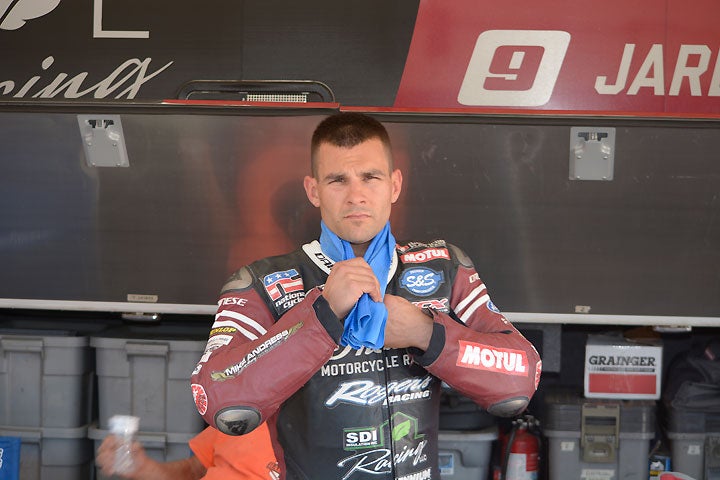
Unfortunately, the combination of a sticky racetrack and my own ring rust didn’t allow me to really put the bike into a race-pace slide to see just how far the chassis can be pushed. On the precious few occasions that I did feel it start to back into Turn 1, the bike didn’t impart a sketchy feel at all, and it would easily fall right back into line as I applied a heavy dose of throttle through the apex and off the corner. This last part was the fun part, as the Scout FTR750 builds revs so quickly and willingly that it felt like a rocket down the straightaways. I’d place the pucker factor squarely in the 10 column.
Are there any weak points in the design? Well, there were, but as Tolbert points out, Indian was really responsive to input by him and Mees during the testing phase. Coming into the season, both men were confident that they had what they needed to win.
“There were some weak spots, but I don’t want to tell you what they were, and we did overcome them,” Tolbert said. “I mean, it’s no secret that the thing spit Jared off and broke his shoulder when we first got started. After that, those first five engines became dyno engines only. We were given strict orders not to ride them, and Indian went right back to the drawing boards and fixed the problems. The next thing you know, here we are and it’s all good.”
I had already traveled at a pace that was better than I’d expected, and I was looking forward to more when the checkered flag flew, ending my all-too-brief introduction to what, in my mind, is perhaps Indian’s greatest success since Polaris revived the brand. The Scout FTR750 is an amazing motorcycle, and while it would be a disservice to downplay the tremendous effort put in by the Indian Wrecking Crew and its talented band of mechanics and crew who helped make the machine a champion in its debut season, they clearly had a great motorcycle to start with.
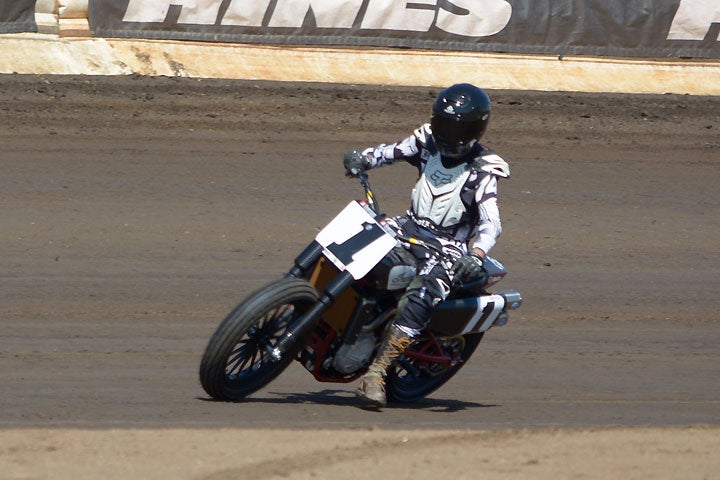
All that remains to be seen now is how Harley-Davidson will respond. It’s no secret that the Vance & Hines-led factory effort has clearly struggled while continuing to develop the still-new XG750R into a consistently competitive machine. It’s to Harley’s credit that it went all-in on the project, abandoning the venerable XR750R, which is a known quantity. It makes me wonder just how much more fun the sport will be to watch if and when Harley-Davidson is able to challenge Indian week in and week out with the XG750R. Throw in Yamaha’s increasingly competitive FZ-07-based racers and the already competitive Kawasaki-powered machines out there, and the series can only get more interesting.
The Indian Scout FTR750 is the best motorcycle in its class right now, and with Indian’s announcement of a massive, $350,000 contingency program for Scout FTR750-mounted privateers in the American Flat Track Series, it’s clearly here to stay.
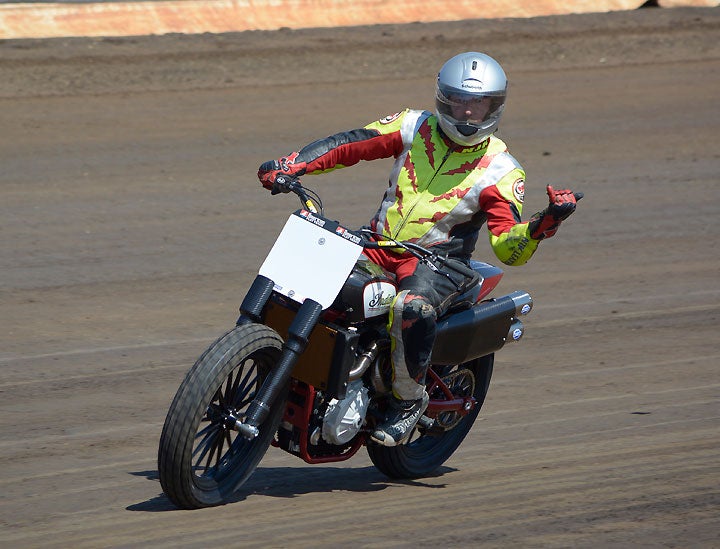
 Your Privacy Choices
Your Privacy Choices